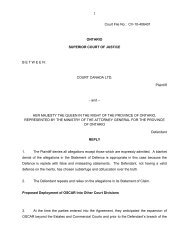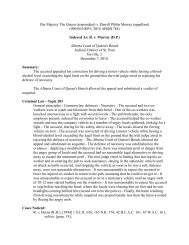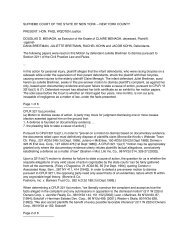A.I. Enterprises Ltd. and Alan Schelew (appellants) v. Bram ... - Slaw
A.I. Enterprises Ltd. and Alan Schelew (appellants) v. Bram ... - Slaw
A.I. Enterprises Ltd. and Alan Schelew (appellants) v. Bram ... - Slaw
Create successful ePaper yourself
Turn your PDF publications into a flip-book with our unique Google optimized e-Paper software.
A.I. <strong>Enterprises</strong> <strong>Ltd</strong>. <strong>and</strong> <strong>Alan</strong> <strong>Schelew</strong> (<strong>appellants</strong>) v. <strong>Bram</strong> <strong>Enterprises</strong> <strong>Ltd</strong>. <strong>and</strong> Jamb<strong>Enterprises</strong> <strong>Ltd</strong>. (respondents)(108-10-CA; 2012 NBCA 33)Indexed As: <strong>Bram</strong> <strong>Enterprises</strong> <strong>Ltd</strong>. et al. v. A.I. <strong>Enterprises</strong> <strong>Ltd</strong>. et al.Répertorié: <strong>Bram</strong> <strong>Enterprises</strong> <strong>Ltd</strong>. et al. v. A.I. <strong>Enterprises</strong> <strong>Ltd</strong>. et al.New Brunswick Court of AppealRobertson, Bell <strong>and</strong> Green, JJ.A.April 12, 2012.Summary:Résumé:Three corporations (<strong>Bram</strong> <strong>Enterprises</strong>, Jamb <strong>Enterprises</strong> <strong>and</strong> A.I. <strong>Enterprises</strong>) acquired anapartment building. The relationship between the parties was regulated by a "syndicationagreement". The syndication agreement provided that if the majority decided to sell, theminority would have the right to purchase the building at its appraised value, failing which theproperty could be marketed to the public. In April 2000, resolutions were passed calling forthe sale of the building. A.I. <strong>Enterprises</strong>, the minority investor, objected, but declined theopportunity to purchase the building at its appraised value of $2.2 million. Nonetheless,<strong>Schelew</strong>, the president <strong>and</strong> sole shareholder of A.I. <strong>Enterprises</strong>, continued to resist any sale ofthe property on the ostensible ground of the majority's non-compliance with the syndicationagreement. <strong>Schelew</strong> instituted arbitration proceedings, registered documents encumbering theproperty's title <strong>and</strong> denied third parties access to the building for inspection purposes. Duringthat time, the majority received <strong>and</strong> accepted two offers from distinct purchasers, one for$2.58 million <strong>and</strong> the other for $2.5 million. However, neither transaction closed withouteither vendor or purchaser being in breach of the underlying agreement of purchase <strong>and</strong> sale.In 2002, the majority sold the building to the A.I. <strong>Enterprises</strong> for its most recent appraisedvalue of $2.2 million. The majority investors (<strong>Bram</strong> <strong>Enterprises</strong> <strong>and</strong> Jamb <strong>Enterprises</strong>) sued<strong>Schelew</strong> <strong>and</strong> A.I. <strong>Enterprises</strong> for damages equal to the difference between what the majoritywould have received, had the property sold to one of the two prospective purchasers in 2000,<strong>and</strong> the price which the minority paid.The New Brunswick Court of Queen's Bench, Trial Division, allowed the claim (see 2010NBQB 245). The court concluded that the tort of unlawful interference with economicrelations had been established. <strong>Bram</strong> <strong>Enterprises</strong> <strong>and</strong> Jamb <strong>Enterprises</strong> were each awardeddamages of $183,061, <strong>and</strong> costs of $14,478. <strong>Schelew</strong> <strong>and</strong> A.I. <strong>Enterprises</strong> appealed.The New Brunswick Court of Appeal dismissed the appeal.Damages - Topic 4044Interference with economic relations - Interference with business relations - Measure ofdamages - [See fifth Torts - Topic 5023].Torts - Topic 5023
Interference with economic relations - Elements of liability - Use of unlawful means - TheNew Brunswick Court of Appeal discussed the tort of inducing breach of contract (Ainduces B to breach its contract with C) <strong>and</strong> the unlawful means tort (A induces B not tocontract with C) - The court stated that "While the two torts differ in several respects, oneis palpable. The inducement tort must involve a breach of contract. Not so with respect tothe unlawful means tort. The interference may simply prevent the formation of a contractor its due performance without resulting in a breach. The second difference is that theinducement tort is not concerned with the means chosen to induce the breach of contract.In short, it matters not whether the means chosen are lawful or unlawful. Obviously, not sowith respect to the unlawful means tort, where the task is to properly define 'unlawfulmeans'. Another difference between the two torts lies in the requirement of establishing'intent'. Under the inducement tort, the claimant must establish the defendant's intent toinduce the breach. Under the unlawful means tort, the claimant must establish thedefendant's intent to cause the claimant harm" - See paragraph 2.Torts - Topic 5023Interference with economic relations - Elements of liability - Use of unlawful means - TheNew Brunswick Court of Appeal examined the unlawful means tort <strong>and</strong> the issue ofwhether the Court should adopt the narrow definition of "unlawful means" articulated inthe majority opinion of Lord Hoffmann in OBG <strong>Ltd</strong>. et al. v. Allan et al. (H.L.) - Therein,"unlawful means" were defined in terms of the defendant's impugned acts beingindependently actionable by the third party, or would have been had the third party suffereda loss - In short, unlawful interference embraced an actionable civil wrong committedagainst a third party - The critical issue was whether the independent actionabilityrequirement should be flexible <strong>and</strong> allow for exceptions, or exceptional categories, whichwere principled in nature <strong>and</strong> did not attract the criticism of ad hoc decision making - Thecourt concluded that that question should be answered in the affirmative - See paragraphs 3to 5.Torts - Topic 5023Interference with economic relations - Elements of liability - Use of unlawful means - TheNew Brunswick Court of Appeal provided an overview of the intentional economic tortsdealing with interference of contractual relations as viewed from the analysis offered inOBG <strong>Ltd</strong>. et al. v. Allan et al. (H.L.) - The court also considered the Canadian framework -The court stated that "This leads me to the point where this Court must isolate the essentialtenets of the unlawful means tort. Building upon OBG <strong>and</strong> the earlier Canadian precedents,including Sagaz, I would offer the following general model which may, with the fullness oftime, need refinement. The plaintiff/claimant must establish: (1) the existence of a validbusiness relationship between the claimant <strong>and</strong> the third party; (2) the defendant knew orought to have known of the relationship; (3) the defendant's interference prevented theformation of a contract or its performance in circumstances where there is no breach of anexisting contract; (4) the defendant's impugned conduct must qualify as unlawful means oras warranting exceptional treatment; (5) the unlawful means must not be actionabledirectly by the claimant; (6) the defendant must have intended to cause the claimant harm;<strong>and</strong> (7) the defendant's conduct must have been the proximate cause of the claimant's loss.From the defendant's perspective, the analytical framework should embrace: (8) the
defence of justification" - The court elaborated on the defence of justification - Seeparagraphs 23 to 59.Torts - Topic 5023Interference with economic relations - Elements of liability - Use of unlawful means -Three corporations (<strong>Bram</strong> <strong>Enterprises</strong>, Jamb <strong>Enterprises</strong> <strong>and</strong> A.I. <strong>Enterprises</strong>) acquired anapartment building - A "syndication agreement" which regulated the parties' relationshipprovided that if the majority decided to sell, the minority would have the right to purchasethe building at its appraised value, failing which the property could be marketed to thepublic - In April 2000, resolutions were passed calling for the sale of the building - A.I.<strong>Enterprises</strong>, the minority investor, objected, but declined the opportunity to purchase thebuilding at its appraised value of $2.2 million - Nonetheless, <strong>Schelew</strong>, the president <strong>and</strong>sole shareholder of A.I. <strong>Enterprises</strong>, continued to resist any sale on the ostensible ground ofthe majority's non-compliance with the syndication agreement - <strong>Schelew</strong> institutedarbitration proceedings, registered documents encumbering the property's title <strong>and</strong> deniedthird parties access to the building for inspection purposes - During that time, the majorityreceived <strong>and</strong> accepted two offers from distinct purchasers, one for $2.58 million <strong>and</strong> theother for $2.5 million - However, neither transaction closed without either vendor orpurchaser being in breach of the underlying agreement of purchase <strong>and</strong> sale - In 2002, themajority sold the building to A.I. <strong>Enterprises</strong> for its most recent appraised value of $2.2million - The majority investors sued <strong>Schelew</strong> <strong>and</strong> A.I. <strong>Enterprises</strong> for damages equal tothe difference between what the majority would have received, had the property sold to oneof the two prospective purchasers in 2000, <strong>and</strong> the price which the minority paid - Theclaim was allowed - The trial judge concluded that the tort of unlawful interference witheconomic relations had been established - <strong>Schelew</strong> <strong>and</strong> A.I. <strong>Enterprises</strong> appealed - Thedecision in OBG <strong>Ltd</strong>. et al. v. Allan et al. (H.L.) had not been brought to the trial judge'sattention - Applying the definition of "unlawful means" articulated in that case, the<strong>appellants</strong> argued that the appeal had to be allowed as there was no cause of action uponwhich the potential purchasers could have sued either <strong>Schelew</strong> or A.I. <strong>Enterprises</strong> (theindependent actionability requirement) - The New Brunswick Court of Appeal dismissedthe appeal - The court held that the independent actionability requirement should allow forexceptions, or exceptional categories, which were principled in nature <strong>and</strong> this case fellwithin an exceptional category - Although the impugned conduct of <strong>Schelew</strong> <strong>and</strong> A.I.<strong>Enterprises</strong> did not satisfy the requirement of being independently actionable by a thirdparty, the facts of the case were akin to the tort of abuse of process - See paragraphs 6 to 9<strong>and</strong> 78 to 83.Torts - Topic 5023Interference with economic relations - Elements of liability - Use of unlawful means -Three corporations (<strong>Bram</strong> <strong>Enterprises</strong>, Jamb <strong>Enterprises</strong> <strong>and</strong> A.I. <strong>Enterprises</strong>) acquired anapartment building - The trial judge found that the minority investor (A.I. <strong>Enterprises</strong>) <strong>and</strong>its president <strong>and</strong> sole shareholder (<strong>Schelew</strong>) committed the tort of unlawful interferencewith economic relations by their conduct in resisting a sale of the property by the majorityinvestors - The majority investors had received <strong>and</strong> accepted two offers, one fromBloomfield Holdings <strong>Ltd</strong>. for $2.58 million <strong>and</strong> the other from Greenarm Development<strong>Ltd</strong>. for $2.5 million - Both Bloomfield <strong>and</strong> Greenarm had subsequently withdrawn from
the transaction - <strong>Schelew</strong> <strong>and</strong> A.I. <strong>Enterprises</strong> appealed - They argued that the respondentsfailed to establish that the <strong>appellants</strong>' conduct was the proximate cause of the decision ofeither Bloomfield or Greenarm to withdraw from their respective sales contracts - The NewBrunswick Court of Appeal held that the plaintiffs failed to establish that <strong>Schelew</strong>'s actionswere the proximate cause of Bloomfield's decision to withdraw from the sale transaction -However, the reason underscoring Greenarm's decision to withdraw was based entirely on<strong>Schelew</strong>'s conduct - The court therefore rejected the <strong>appellants</strong>' "temporal" <strong>and</strong> "proximatecause" arguments - See paragraphs 63 to 70 - With respect to damages, the trial judge'sdecision to assess damages based on the selling price under the Bloomfield agreement($2.58 million) was justified - While the respondents failed to establish that the <strong>appellants</strong>were the proximate cause of Bloomfield's decision to withdraw, that did not mean thatBloomfield's offer to pay $2.58 million was not relevant when establishing the fair marketvalue of the property - See paragraph 88.Torts - Topic 5023Interference with economic relations - Elements of liability - Use of unlawful means -Three corporations (<strong>Bram</strong> <strong>Enterprises</strong>, Jamb <strong>Enterprises</strong> <strong>and</strong> A.I. <strong>Enterprises</strong>) acquired anapartment building - The trial judge found that the minority investor (A.I. <strong>Enterprises</strong>) <strong>and</strong>its president <strong>and</strong> sole shareholder (<strong>Schelew</strong>) committed the tort of unlawful interferencewith economic relations by their conduct in resisting a sale of the property by the majorityinvestors - The majority investors had received <strong>and</strong> accepted offers from two distinctpurchasers who had subsequently withdrawn from the transaction - <strong>Schelew</strong> <strong>and</strong> A.I.<strong>Enterprises</strong> appealed - They argued that to establish the requisite intent, a plaintiff had toestablish that the defendant knew of the contractual relationship between the plaintiff <strong>and</strong>the third party - The New Brunswick Court of Appeal rejected the argument - <strong>Schelew</strong>knew that various persons were negotiating with the majority investors <strong>and</strong> that wassufficient to satisfy the legal requirement that the defendant have knowledge of theclaimant's business relationship with third parties - More importantly, it had not beenshown why the identity of the potential purchasers <strong>and</strong> the terms of any executory contractshould impact on the establishment of the tort - See paragraphs 71 to 75.Torts - Topic 5024Interference with economic relations - Elements of liability - Malice or intent to injure -Three corporations (<strong>Bram</strong> <strong>Enterprises</strong>, Jamb <strong>Enterprises</strong> <strong>and</strong> A.I. <strong>Enterprises</strong>) acquired anapartment building - The trial judge found that the minority investor (A.I. <strong>Enterprises</strong>) <strong>and</strong>its president <strong>and</strong> sole shareholder (<strong>Schelew</strong>) committed the tort of unlawful interferencewith economic relations by their conduct in resisting a sale of the property by the majorityinvestors - The majority investors had received <strong>and</strong> accepted offers from two distinctpurchasers who had subsequently withdrawn from the transaction - <strong>Schelew</strong> <strong>and</strong> A.I.<strong>Enterprises</strong> appealed - They argued that in order to establish the requisite intent, a claimanthad to establish that the unlawful conduct was deliberately targeted with the purpose ofinflicting economic injury on the claimant - Correlatively, intent had not been established ifthe harm was simply an incidental or foreseeable result of the defendant's unlawful conduct- The <strong>appellants</strong> maintained the present case fell within that framework - The NewBrunswick Court of Appeal held that the trial judge did not err - The court stated, inter alia,"one can properly conclude the injury to the respondent investors was the means of
attaining the <strong>appellants</strong>' desired end of preventing any sale of the property <strong>and</strong> not merely aforeseeable consequence of having done so" - See paragraphs 76 to 77.Torts - Topic 5208Interference with economic relations - Contracts - Inducing breach of contract - [See firstTorts - Topic 5023].Torts - Topic 5210Interference with economic relations - Contracts - Interference with contractual rights -[See all Torts - Topic 5023].Torts - Topic 5215Interference with economic relations - Contracts - Defences - Justification - [See thirdTorts - Topic 5023].Délits civils - Cote 5023Atteintes aux relations économiques - ༄༅lེments de responsabilitེ - Usage de moyensillེgaux - [Voir Torts - Topic 5023].Délits civils - Cote 5024Atteintes aux relations économiques - ༄༅lེments de responsabilitེ - Malice ou causerintentionnellement un prེjudice - [Voir Torts - Topic 5024].Délits civils - Cote 5208Atteintes aux relations économiques - Contrats - Incitation à la rupture de contrat - [VoirTorts - Topic 5208].Délits civils - Cote 5210Atteintes aux relations économiques - Contrats - Atteintes aux droits contractuels - [VoirTorts - Topic 5210].Délits civils - Cote 5215Atteinte aux relations économiques - Contrats - Moyens de défense - Justification - [VoirTorts - Topic 5215].Dommages-intérêts - Cote 4044Atteinte aux relations économiques - Atteinte aux relations commerciales - Based'évaluation des dommages-intérêts - [Voir Damages - Topic 4044].Cases Noticed:Lumley v. Gye (1853), 118 E.R. 749 (Q.B.), refd to. [para. 2].Allen v. Flood, [1898] A.C. 1 (H.L.), refd to. [para. 2].OBG <strong>Ltd</strong>. et al. v. Allan et al., [2007] 4 All E.R. 545; [2007] 1 A.C. 1; 369 N.R. 66; [2007]UKHL 21, consd. [para. 2].Alleslev-Krofchak et al. v. Valcom <strong>Ltd</strong>. et al. (2010), 266 O.A.C. 356; 2010 ONCA 557,refd to. [para. 5].
Correia v. Canac Kitchens et al. (2008), 240 O.A.C. 153; 91 O.R.(3d) 353; 2008 ONCA506, refd to. [para. 5].Total Network SL v. United Kingdom (Her Majesty's Revenue <strong>and</strong> Customs) (2008), 385N.R. 310; [2008] UKHL 19, refd to. [para. 5].Agribr<strong>and</strong>s Purina Canada Inc. v. Kasamekas et al. (2011), 278 O.A.C. 363; 106 O.R.(3d)427; 2011 ONCA 460, refd to. [para. 5].SAR Petroleum Inc. et al. v. Peace Hills Trust Co. (2010), 357 N.B.R.(2d) 202; 923 A.P.R.202; 2010 NBCA 22, refd to. [para. 18].Carnahan v. McGregor <strong>and</strong> Whalen (1994), 149 N.B.R.(2d) 342; 381 A.P.R. 342 (C.A.),refd to. [para. 21].Dufferin Real Estate <strong>Ltd</strong>. v. Giralico, [1989] O.J. No. 1525 (H.C.J.), refd to. [para. 21].Reid et al. v. Egg Marketing Board (B.C.), [2007] B.C.T.C. Uned. B21; 2007 BCSC 155,refd to. [para. 22].D.C. Thomson & Co. <strong>Ltd</strong>. v. Deakin <strong>and</strong> Others, [1952] 1 Ch. 646 (C.A.), refd to. [para.25].Rookes v. Barnard, [1964] A.C. 1129 (H.L.), refd to. [para. 30].South Wales Miners' Federation v. Glamorgan Coal Co., [1905] A.C. 239 (H.L.), refd to.[para. 35].RCA Corporation v. Pollard, [1983] Ch. 135 (C.A.), refd to. [para. 40].OBG <strong>Ltd</strong>. v. Allen, [2005] EWCA Civ. 106, refd to. [para. 42].Roman Corp. v. Hudson's Bay Oil <strong>and</strong> Gas Co., [1973] S.C.R. 820, refd to. [para. 44].International Brotherhood of Teamsters v. Therien, [1960] S.C.R. 265, refd to. [para. 44].Canada Cement LaFarge <strong>Ltd</strong>. et al. v. British Columbia Lightweight Aggregate <strong>Ltd</strong>. et al.,[1983] 1 S.C.R. 452; 47 N.R. 191, refd to. [para. 44].Saskatchewan Wheat Pool v. Canada, [1983] 1 S.C.R. 205; 45 N.R. 425, refd to. [para. 44].Torquay Hotel C. <strong>Ltd</strong>. v. Cousins <strong>and</strong> Others, [1969] 1 All E.R. 522 (C.A.), refd to. [para.47].671122 Ontario <strong>Ltd</strong>. v. Sagaz Industries Canada Inc. et al. (1998), 67 O.T.C. 22 (Gen.Div.), refd to. [para. 49].Mallard v. Saskatchewan Financial Services Commission et al., [2011] Sask.R. Uned. 30;2011 SKCA 38, refd to. [para. 52].Conway et al. v. Zinkhofer, [2008] A.R. Uned. 306; 2008 ABCA 392, refd to. [para. 52].Reach M.D. Inc. v. Pharmaceutical Manufacturers Association of Canada et al. (2003), 172O.A.C. 202 (C.A.), refd to. [para. 52].Lineal Group Inc. v. Atlantis Canadian Distributors Inc., [1998] O.A.C. Uned. 450 (C.A.),refd to. [para. 53].Drouillard v. Cogeco Cable Inc. et al. (2007), 223 O.A.C. 350; 2007 ONCA 322, refd to.[para. 53].O'Dwyer v. Ontario Racing Commission (2008), 238 O.A.C. 364; 2008 ONCA 446, refdto. [para. 53].Barber et al. v. Vrozos et al. (2010), 269 O.A.C. 108; 322 D.L.R.(4th) 577; 2010 ONCA570, refd to. [para. 53].Print N' Promotion (Canada) <strong>Ltd</strong>. v. Kovachis et al. (2011), 271 O.A.C. 214; 2011 ONCA23, refd to. [para. 58].Doucet et al. v. Spielo Manufacturing Inc. et al. (2011), 372 N.B.R.(2d) 1; 961 A.P.R. 1;2011 NBCA 44, refd to. [para. 85].
S. & S. Industries Inc. v. Rowell, [1966] S.C.R. 419; 56 D.L.R.(2d) 501, refd to. [para. 86].Skinner v. Perry (1893), 10 R.P.C. 1, refd to. [para. 86].Tersigni v. Fagan, [1959] O.J. No. 65 (C.A.), refd to. [para. 86].Pete <strong>and</strong> Martys (Front) <strong>Ltd</strong>. v. Market Block Toronto Properties <strong>Ltd</strong>., [1985] O.J. No. 564(H.C.J.), refd to. [para. 86].Geo. Cluthe Manufacturing Co. et al. v. ZTW Properties Inc. et al. (1995), 81 O.A.C. 141(Div. Ct.), refd to. [para. 86].Schurman v. Covered Bridge Recreation Inc. (2009), 340 N.B.R.(2d) 168; 871 A.P.R. 168;2009 NBCA 1, refd to. [para. 88].Authors <strong>and</strong> Works Noticed:Burns, Peter T., <strong>and</strong> Blom, Joost, Economic Interests in Canadian Tort Law (2009), [para.45].Burns, Peter, Tort Injury To Economic Interests: Some Facets Of Legal Response (1980),58 Can. B. Rev. 103, p. 141 [para. 46].Fridman, Gerald Henry Louis, The Law of Torts in Canada (3rd Ed. 2010), [para. 45].Halsbury's Laws of Engl<strong>and</strong> (4th Ed. 1985), vol. 45, para. 1531 [para. 86].Klar, Lewis N., Tort Law (4th Ed. 2008), [para. 45].Osborne, Philip, The Law of Torts (2nd Ed. 2003), p. 238 [para. 83].O'Sullivan, Janet, Intentional Economic Torts in the House of Lords, [2007] C.L.J. 503, pp.504 [para. 25]; 505 [para. 27].O'Sullivan, Janet, Unlawful Means Conspiracy in the House of Lords, [2008] C.L.J. 459,[para. 32].Prosser, William Lloyd, <strong>and</strong> Keeton, W. Page, Prosser <strong>and</strong> Keeton on Torts (5th ed. 1984),p. 1005 [para. 21].Sopinka, John, Lederman, Sidney N., <strong>and</strong> Bryant, <strong>Alan</strong> W., The Law of Evidence inCanada (3rd Ed. 2009), para. 2.35 [para. 65].Counsel:Avocats:Richard J. Scott, Q.C., <strong>and</strong> Jennifer D. Snow, for the <strong>appellants</strong>;Charles A. LeBlond, Q.C., for the respondents.This appeal was heard on November 23, 2011, before Robertson, Bell <strong>and</strong> Green, JJ.A., ofthe New Brunswick Court of Appeal. The following judgment of the Court of Appeal wasdelivered by Robertson, J.A., on April 12, 2012.Editor: Angela E. McKayAppeal dismissed.


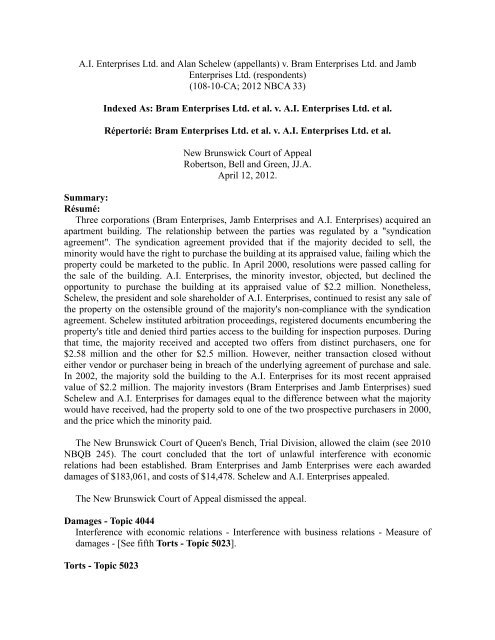
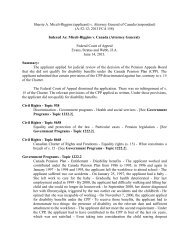

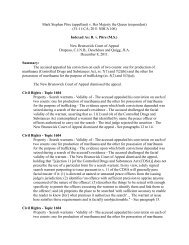
![Jones (appellant) v. Kaney (respondent) ([2011] UKSC 13 ... - Slaw](https://img.yumpu.com/46577625/1/190x245/jones-appellant-v-kaney-respondent-2011-uksc-13-slaw.jpg?quality=85)
